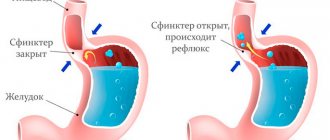Indications for testing for Helicobacter pylori
The bacterium Helicobacter pylori is a gram-negative spiral-shaped pathogenic microorganism that inhabits the antrum of the stomach and intestines. The waste products of the bacteria lead to the fact that the mucous membrane of these organs of the digestive system will become inflamed, ulcers and erosions will appear on it. In the future, if left untreated, this will lead to the development of diseases such as gastritis, stomach ulcers and even stomach cancer. For the discovery of this bacterium, two scientists (Robin Warren and Barry Marshall) received the Nobel Prize.
Helicobacter pylori can be transmitted from one person to another by kissing or by using common household items. Therefore, the bacterium first enters the body most often in childhood. The acidic environment of the stomach is not capable of destroying the microorganism, since it has its own defense mechanisms against it.
Sometimes the disease begins to develop immediately after the infection has occurred, and sometimes after a certain time interval. Often, a bacterium can exist completely asymptomatically in the body for several years and manifests its activity only as a result of a combination of certain factors, for example, after suffering stress or against the background of a sharp decrease in immunity.
A test for the presence of Helicobacter pylori should be done for those people who have symptoms of disorders of the digestive system, including:
- Frequent belching.
- Heartburn with secretion of acidic contents.
- Hiccups.
- Bad breath due to the health of the oral cavity itself.
- Stomach pain, feeling of discomfort.
- Abnormal bowel movements, in which diarrhea may be replaced by constipation.
- Symptoms indicating a failure in metabolic processes: hair loss, dry skin, increased brittleness of nails.
- Rapid saturation with small portions of food, disturbances in its digestion.
- Meat intolerance.
If a person has any of the above symptoms, they should be tested for Helicobacter pylori. Also, all family members should be tested, provided that one of them was found to have this bacterium.
This evil Helicobacter
Many representatives of the Helicobacter genus are dangerous to humans. Different types can inhabit the mucous membranes of the oral cavity, intestines, and stomach. It is known that the main carrier of the parasite is humans. It already infects domestic animals - dogs and cats, which are also capable of carrying the infection. The most dangerous strains are:
- H. pylori;
- H. nemestrinae;
- H. acinonychis;
- H. salomonis.
All representatives of the genus are characterized by a unique ability to survive in an acidic environment. The structure of bacteria is also approximately similar. They have a rod-shaped curved body, with 4-6 flagella. With their help, microbes quickly move across the surface of mucous membranes. Even the thick secretion of the gastric walls becomes a kind of “skating rink” for them. By destroying the mucus barrier, bacteria reach epithelial cells, to which they can cling with their “legs” and even penetrate into the deeper layers.
For microbes to thrive, they need a humid environment and a minimum of oxygen (much less than what is in the atmosphere). Helicobacter feeds on energy obtained from the oxidation of molecular hydrogen by hydrogenase (its own enzyme). Thus, the microbe uses the waste products of other microorganisms for its own purposes.
In a favorable environment, Helicobacter quietly exists, multiplies, colonizes mucous membranes, displacing beneficial bacteria and leaving toxic waste products. When the environment deteriorates, exposure to substances hazardous to the microbe, and as the bacteria age, the bacteria may transform into the coccal form. The nucleotide structure of the cell's DNA changes, the cell itself becomes round and loses its flagella. However, the ability to penetrate living cells remains, as does the ability to release toxins. But the human immune system does not recognize the “spore” as a threat and does not attack it with antibodies.
Special Features
Scientists for a long time could not come to terms with the infectious theory of the origin of gastritis, since it was believed that not a single living organism could survive in the aggressive acidic environment of the stomach. A detailed study of Helicobacter gave reason to understand that special microbes exist and they are adapted to “acidic life” by special mechanisms. Helicobacter knows how to search for and create optimal living conditions for itself. This happens in several ways:
- due to flagella - the bacterium quickly moves and hides in the folds of the gastric walls, where less acid enters;
- special places - the microbe “loves” the pyloric part of the stomach, where the food bolus is most often located, and food somewhat reduces the acidity of gastric juice;
- urease enzyme - with its help, the bacterium processes urea in protective mucus, and the resulting ammonia and carbon dioxide surround it like a cloud, simultaneously reducing the acidity of the environment right next to the bacterium, thus it itself alkalizes the space around itself;
- biofilms are dense protective shells formed when Helicobacter enzymes come into contact with proteins and other environmental substances; they protect the microbe from acid, antibiotics and other adverse effects;
- phospholipase enzyme - this compound dissolves the protective mucus on the walls of the stomach, and the bacterium gets the opportunity to go deeper and attach to the epithelial cells;
- cytotoxins - by releasing them into cells, Helicobacter activates inflammatory changes in the walls of the stomach and activates immune reactions, however, instead of the bacterium itself, the protective cells destroy their own, which aggravates the inflammation and provokes the destruction of the stomach lining.
Thus, it is clear that Helicobacter pylori not only knows how to adapt and defend itself, it also triggers processes of destruction in tissues. It is characteristic that microbial cytotoxins can trigger the process of necrotization and degeneration of epithelial tissue. Normal cells in the stomach walls undergo hyperplasia and are replaced by intestinal epithelium. This looks like wall atrophy. The affected areas are not able to produce gastric juice and protect themselves with mucus, and therefore quickly become damaged and “perforated”, forming ulcers.
Helicobacter toxins have carcinogenic properties. A direct connection has been established between the microbe and the development of stomach cancer, gynecological oncopathologies and breast cancer in women, as well as prostate cancer in men. Relatives of cancer patients with stomach damage should be examined for helicobacteriosis.
The essence of the urease breath test for Helicobacter pylori
The breath test is based on the ability of bacteria to secrete a special enzyme - urease. It is necessary for Helicobacter pylori to prevent human gastric juice from destroying its lining.
In the stomach, urease breaks down urea into ammonia and carbon dioxide. The gas is released into the external environment. This is what the analyzer picks up.
There are several types of urease breath test for Helicobacter pylori, including:
- Breath urease test using isotope-labeled urea. In this case, during the procedure, the subject drinks a solution of urea, which was previously labeled with isotopes.
- 13C-urease breath test. In this case, urea labeled with the stable non-radioactive isotope C13 acts as a loading solution.
- Helic test. When conducting a helic test, they use not urea, but a urea solution.
Regardless of what type of examination is performed on the patient, they all have a high degree of accuracy.
Types of breath tests and methods for conducting them
In total, there are 3 types of breath tests, which differ from each other both in the time of implementation and in the elements in which the analysis is collected, that is, exhaled air. So the shortest test is the helica breathing test. The longest time-consuming test is the breath test using urea. The duration of the procedure is at least 40 minutes, but sometimes the duration can be up to 1 hour. The 13 C analysis is average in time; its duration rarely reaches 40 minutes.
It is worth knowing, although these methods of respiratory research have significant differences among themselves. The test preparation program is mandatory for each of them and does not have any distinctive criteria.
In addition to the duration, the respiratory methods used to determine bacteria differ in other elements:
- Helic test. This analysis is the only one among breathing methods that is approved for use by children and pregnant women. The safety of this test is due to the urea used instead of isotopes. 0.5 grams of urea is used as a load. This analysis aims to compare the level of gas concentration that occurs after a patient drinks a special liquid. The research procedure itself is also simple. The tube used for breathing should be deep in the mouth. Initially, the patient breathes through a tube without taking any special liquid. After 6 minutes, the tube is removed and the urea solution is drunk. After this procedure, the tube is again placed in the mouth and over the next 6 minutes, the patient breathes through it again;
- Breath test using urea. This type of examination of the body for Helicobacter pylori begins with calm breathing, which should be carried out with a tube located deep in the patient’s mouth. During the first stage, two air samples are collected for research. After this procedure, the patient needs to drink a special test solution containing labeled isotopes of urea. After taking the liquid, wait 15 minutes, after which four air samples are taken;
- The 13C breath test is considered by many experts to be the most accurate and at the same time safe. During the Helicobacter pylori test, the patient only needs to take two air samples. The first air intake is carried out in the morning, the air is exhaled into a sealed bag. After this procedure, the patient needs to drink a loading solution, which takes 30 minutes to absorb. After the time has elapsed, a second intake of exhaled air is carried out into a special bag.
Preparation for the procedure
Before being tested for Helicobacter pylori, the patient must carry out a number of preparatory measures.
- The study is prescribed no earlier than 3-6 days after taking antibiotics or antisecretory drugs. Also, 5 days before the procedure, you should avoid taking painkillers, antacids and NSAIDs. If a person takes any medications on an ongoing basis, he should consult a doctor about this to clarify the possibility of the procedure.
- At least 3 days before the study, you will need to avoid drinking alcoholic beverages.
- The day before the procedure, you should not eat foods that increase gas formation. It is recommended to remove potatoes, bakery and confectionery products, cabbage, peas and beans from the menu.
- The evening before the test, you should have a light dinner. Meals should take place 2-3 hours before bedtime.
- At least 6 hours must pass between the study and the last meal. The procedure is performed on an empty stomach.
- It is forbidden to eat in the morning; you should refrain from using chewing gum.
- You are not allowed to smoke before the procedure. You need to give up tobacco 3-4 hours before the procedure.
- Before performing the test, you should brush your teeth and rinse your mouth.
- You can drink water for the last time an hour before the test, but its volume should not exceed 100 ml.
If you follow all the suggested recommendations, the test result will be as reliable as possible.
Traditional methods of treatment
Traditional medicine has its own methods of treating stomach diseases caused by Helicobacter pylori. Naturally, they are less effective than drug therapy, have not been tested in clinical settings, and can cause harm if used incorrectly.
Before using unconventional methods, you should consult your doctor. In some cases, treatment is required immediately and delay when using traditional methods can lead to very disastrous consequences. When choosing recommendations, you should be guided not only by the fact of the presence of infection, but also by individual characteristics (degree of gastric juice activity, symptoms of the disease).
Propolis
Pharmacy tincture of propolis is used for treatment. It is affordable and sold in almost every pharmacy. The product is well suited for the treatment of chronic gastritis with reduced acidity. In other forms, the drug is used only if it is well tolerated (if there is no pain, heartburn, or dyspeptic disorders).
Propolis is taken 10 drops, dissolving it in a glass of water at room temperature. The solution is taken an hour before meals, 3-4 times a day. The course is 100 ml of tincture. After its completion, you need to take a break of 2-6 weeks. The more intense the symptoms of the disease, the shorter the interval. The courses are repeated until complete recovery.
Medicinal fee
Used for gastritis and peptic ulcers in the remission phase, to prevent the reactivation of Helicobacter pylori. Mix dried apple and pear flowers, lingonberry and strawberry leaves. A tablespoon of berries is poured into a thermos with half a liter of boiling water. In the morning, filter the infusion, take half a glass in between meals. The course of treatment is a month. It is best to carry it out during the off-season, when the risk of exacerbation of gastrointestinal diseases is high.
Garlic
Garlic contains organic acids, phytoncides, essential oils and other beneficial substances. It not only fights pathogenic microflora, but also strengthens the immune system, heart muscle, cleanses blood vessels and regulates lipid metabolism, stimulates regeneration processes.
You can prepare the medicine immediately before taking it. To do this, peeled garlic is grated on a fine grater or passed through a crusher. You need to get 1 tablespoon of gruel without a slide. It is mixed with a teaspoon of honey for increased gastric secretion or with a teaspoon of lemon juice for low acidity. The remedy is taken in the morning on an empty stomach immediately after waking up, washed down with a glass of boiled water. The course of treatment lasts 2 weeks. After this, a 2-week break is observed and the therapy is repeated.
The method is contraindicated for stomach ulcers, gallstones or kidney stones. The method should be used with caution in diseases of the urinary system.
Raw potatoes to the rescue
Peel the potato tubers, pass them through a meat grinder or grind them in a blender. Next, squeeze out the potato juice through gauze folded in several layers. The resulting juice is taken half a glass half an hour before meals 4 times a day. The course of treatment is 2 weeks.
The product works by reducing acidity in the stomach, and therefore helps in the treatment of hyperacid gastritis. It can also be used when there is a threat of ulcer formation.
Sagebrush
This plant has powerful bactericidal properties. However, it can also stimulate the secretion of hydrochloric acid, so patients with hyperacidity and ulcers should be careful. The method is more suitable for chronic hyposecretory gastritis with atrophic changes in the gastric mucosa.
It is necessary to prepare a tincture of wormwood. To do this, the green parts of the plant are loosely placed in a glass container, filling it to a third of its volume. The vessel is filled to the top with high-quality vodka, closed with a lid, and placed in a dark place for a week. After infusion, take 2 tablespoons in the morning and evening before meals. The course of treatment is 14 days. They are repeated with the same break until the condition improves.
How is the urease breath test performed with carbon-labeled urea?
The procedure begins with the patient being asked to breathe through a tube. It is located deep in his mouth, the oral cavity itself will be slightly open. You need to breathe calmly and smoothly. At this time, the doctor takes two air samples.
The patient is then asked to drink an isotope-labeled urea solution. After 15 minutes, another 4 air samples are taken. Care must be taken to ensure that the subject’s saliva does not enter the tube. To do this, he can remove it from time to time and smooth out the accumulated liquid. If it happens that saliva does get inside the sample, then the test should be stopped and repeated after an hour. Although modern devices make it possible to protect air samples from saliva.
Preparation
How to do a urease test? This question interests most parents. The preparation is simple, but begins long before the procedure itself:
- Three weeks before the test, you must stop taking antibiotics, analgesics, anti-inflammatory drugs and antacids.
- During the day it is worth limiting the consumption of foods such as peas, beans, potatoes, brown bread, that is, foods that contribute to gas formation. Dinner should be light, and you will have to skip breakfast altogether.
- On the day of the test, the child must brush his teeth, but chewing gum is not necessary.
How is the 13C-urease breath test performed?
It is the 13C-urease test that is the most commonly used test for identifying Helicobacter pylori. During the procedure, only two air samples are taken from the subject.
The first sample is obtained in the morning on an empty stomach, and the second sample is taken half an hour after taking a solution of urea labeled with the stable isotope C13. The person exhales air into disposable bags that are specially designed for this procedure.
This type of research has a number of advantages, including:
- The diagnostic accuracy is high, reaching 100%.
- The procedure is safe for health, since no radioactive substances are used during its implementation.
- The research doesn't take much time. In general, 40 minutes is enough to complete it.
All about the treatment of Helicobacter pylori infection
Some doctors believe that eradication (complete destruction) of infection is necessary only in the event of the development of associated diseases. A number of scientists and physicians are inclined to prescribe drug eradication only to persons with special needs (progressive gastritis, ulcers, gastric cancer pathologies in close relatives). Most doctors agree that fighting the bacterium in asymptomatic carriers is inappropriate, since the potential harm from antibiotic therapy outweighs the danger of peaceful cohabitation with Helicobacter.
Useful information: Intestinal dysbiosis: 4 symptoms, treatment (25 drugs) in adults and children, diet, microflora tests. How to Choose the Best Probiotic
This is interesting - what is Maastricht
In 1987, a scientific group was created in Europe to study Helicobacter pylori and develop new approaches to treating the infection. Every year the group organizes a congress at which it makes recommendations relevant to the entire medical world. Doctors call the provisions of the Maastricht Consensus “Maastrichts”. Each new set of recommendations complements and updates last year's recommendations.
Some gastroenterologists are skeptical about the work of the scientific group and blame it for the growing antibiotic resistance of Helicobacter pylori. Recently, strains have been identified that are resistant to the “heavy artillery” of antibiotics – Clarithromycin, a group of quinolones. Even multidrug-resistant varieties of bacteria have been discovered (resistant to several groups of antibacterial substances). However, officially the Maastricht recommendations are the leading and preferred direction in the treatment of pathologies associated with Helicobacter.
About treatment regimens
Helicobacter drug eradication regimens refer to special treatment regimens aimed at completely eliminating the infection from the mucous membranes of the stomach. Elimination of the pathogen has a positive effect on the condition of the organ, creating favorable conditions for eliminating the inflammatory process, healing erosions and ulcers. Treatment regimens are constantly being improved to meet specific requirements:
- minimum side effects – side effects of drugs are allowed to occur in 10-15% of patients;
- minimum consequences - it is important that the treatment does not leave behind any adverse consequences, so that it can be resumed after some time (due to the risk of relapse);
- ease of use - scientists are constantly working to ensure that patients need to take as few medications as possible (combined drugs are being developed);
- optimal dosage regimen - it is important that medications can be taken as rarely as possible, this increases the chances of patients complying with the treatment regimen (long-acting substances are used);
- the presence of an alternative - treatment regimens should be interchangeable in case of drug sensitivity of patients to certain drugs;
- prevention of resistance - in the context of increasing resistance of Helicobacter to chemotherapy, it is important to find drugs to which bacteria cannot adapt.
In addition, due to the prevalence of infection, it is important to ensure that therapeutic regimens are affordable. Alternative treatment options should also be prepared in advance in case of relapse. After all, repeated use of antibiotics leads to the development of Helicobacter resistance.
How is the helic test performed to identify Helicobacter pylori?
The helic test is carried out according to the same scheme as the 13C-urease breath test. The only difference is that instead of isotope-labeled urea, a person receives a solution of urea. Air is taken in 2 samples: before taking the solution and after taking it.
The undoubted advantage of the study is its complete safety for human health. This is the best test for detecting Helicobacter pylori in pregnant women and children. However, a number of experts question the accuracy of the results obtained. Therefore, the helic test is carried out only in Russia.
Degree of reliability of results
The accuracy of the study, unfortunately, is not absolute: “the possibility of false-positive results of this test should be taken into account, especially in patients with atrophic gastritis, in whom other types of urease-producing bacteria may develop on the mucous membranes” (1).
Streptococci, Proteus, pseudomonas, and Candida fungi are capable of producing urease.
As N.V. Baryshnikova notes (2),
To increase the accuracy of diagnosing helicobacteriosis, it is recommended to use at least two, and preferably three, research methods, preferably a combination of a rapid urease test or “Helic test” with a histological research method (biopsy from the body of the stomach) or polymerase chain reaction (detection of the ureC gene).
The disadvantage of this method is largely compensated by its important advantage - non-invasiveness. Anyone can go through the procedure as many times as they want.
Interpretation of the results of a breath test for Helicobacter pylori
A breath test can give two results: positive or negative. The patient either has Helicobacter pylori in the body or has not been infected.
Also, using a special device called a mass spectrometer, the quantitative values of Helicobacter pylori in the body are determined.
The data obtained can be interpreted as follows:
- If the stabilized isotope in the exhaled air contains from 1 to 3.4%, then the degree of infection is mild.
- When the isotope concentration is in the range of 3.5-6.4%, they speak of an average degree of infection.
- Severe Helicobacter pylori infection will be indicated by rates of 6.5-9.4%.
- Extremely severe is indicated by values greater than 9.5%.
As a rule, the accuracy of the test is beyond doubt. It is possible to obtain a negative result only if the conditions for preparing for the study are not observed. Some drugs can reduce the activity of gastric juice production, which will make it impossible to break down urea.
Test results will be available 1-2 days after the test. The storage period for collected samples is 10 days, but no more.
Helicobacter pylori bacterium in the stomach - causes of appearance
Due to weaker immunity, the microorganism Helicobacter pylori more often enters the body of children. Helicobacter - routes of infection:
- Fecal-oral - since the bacterium can be isolated in feces, it can enter the body through dirty hands, unwashed plants and fruits, and untreated water.
- Oral-oral - gastroenterologists believe that infection can occur through kissing and sharing utensils.
- Iatrogenic - infection is possible during surgery, diagnostic procedures, for example, during endoscopy.
- It has not been proven, but there is a theory that you can become infected through contact with a cat or through products on which flies have sat.
What to do if the test is positive?
If the test for Helicobacter pylori is positive, then the patient will need to undergo a comprehensive examination of the digestive system. The patient must be sent for an FGDS, which will provide information about the condition of the stomach and duodenum. He will also donate blood for biochemical and general analysis; other studies may be required.
Helicobacter pylori requires treatment. Depending on the severity and nature of the damage to the inner wall of the stomach, a therapeutic regimen is selected. However, to eliminate bacteria, antibiotics are always used, which are combined with proton pump inhibitors. In this case, two antibacterial drugs will be prescribed. This may be Amoxicillin, Levofloxacin, Metronidazole, Clarithromycin, etc.
During treatment or after its completion, the doctor may suggest that the patient take another test for Helicobacter pylori. This is required to monitor the effectiveness of ongoing therapy or to evaluate treatment already performed. A gastroenterologist treats diseases of the digestive system.








